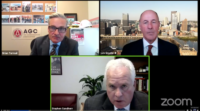The California Water Resources Control Board is accepting public comment through July 28 on new recommendations to expedite permits for seawater desalination plants in the state.
In a report released earlier this month, the state lays out a pathway for project developers to speed up project permits by taking steps that include identifying site locations and technologies set to have only minimal impact on marine life and the environment, such as using intake structures that draw only seawater, and better planning for foreseeable coastal hazards such as seismic risks and sea-level rise. The recommendations also call for projects to be carbon neutral, with the most energy efficient technologies available whenever possible.
Project developers unable to meet the criteria for expedited permits would need to follow a standard permitting process.
The draft expedited permitting report is the culmination of work by an state-federal interagency task force created to conform with the California water supply strategy released by Gov. Gavin Newsom (D) in August 2022 in response to the state's years-long drought conditions.
Currently, California has 14 seawater and 23 brackish water desalination plants, but not all operate at full capacity, according to the strategy report. The city of Antioch is building the state's first inland brackish water desalination project costing about $110 million.
But some industry experts are unconvinced that the expedited permitting recommendations, which they say are likely to be codified into regulations, will move the needle very far.
“The recommended guidelines will likely benefit the implementation of smaller seawater desalination projects,” says Jill Hudkins, Tetra Tech president. But these don’t have the same economies-of-scale as larger ones, she notes. “To be effective, [the guidelines] should address the streamlining of all seawater desalination projects regardless of siting and technology deployed.”
Jay Lund, a professor of environmental engineering at University of California, Davis, adds. "There’s always a concern that when you set up an expedited process … it doesn’t always become very expedited.”
Because most projects have a unique set of conditions and requirements set by regional boards or agencies, it’s a challenge to standardize the approval process, he says. “I suspect we’ll see some small but important applications of seawater desalination, but it will not be a large proportion of the state’s water supply," Lund contends.
However, some utilities in southern California may seek to build on current interest in streamlined desalination permitting, he says. “They will be pioneering the process to see if what can be done does in fact lead to some expedited permitting,” says Lund.






Post a comment to this article
Report Abusive Comment